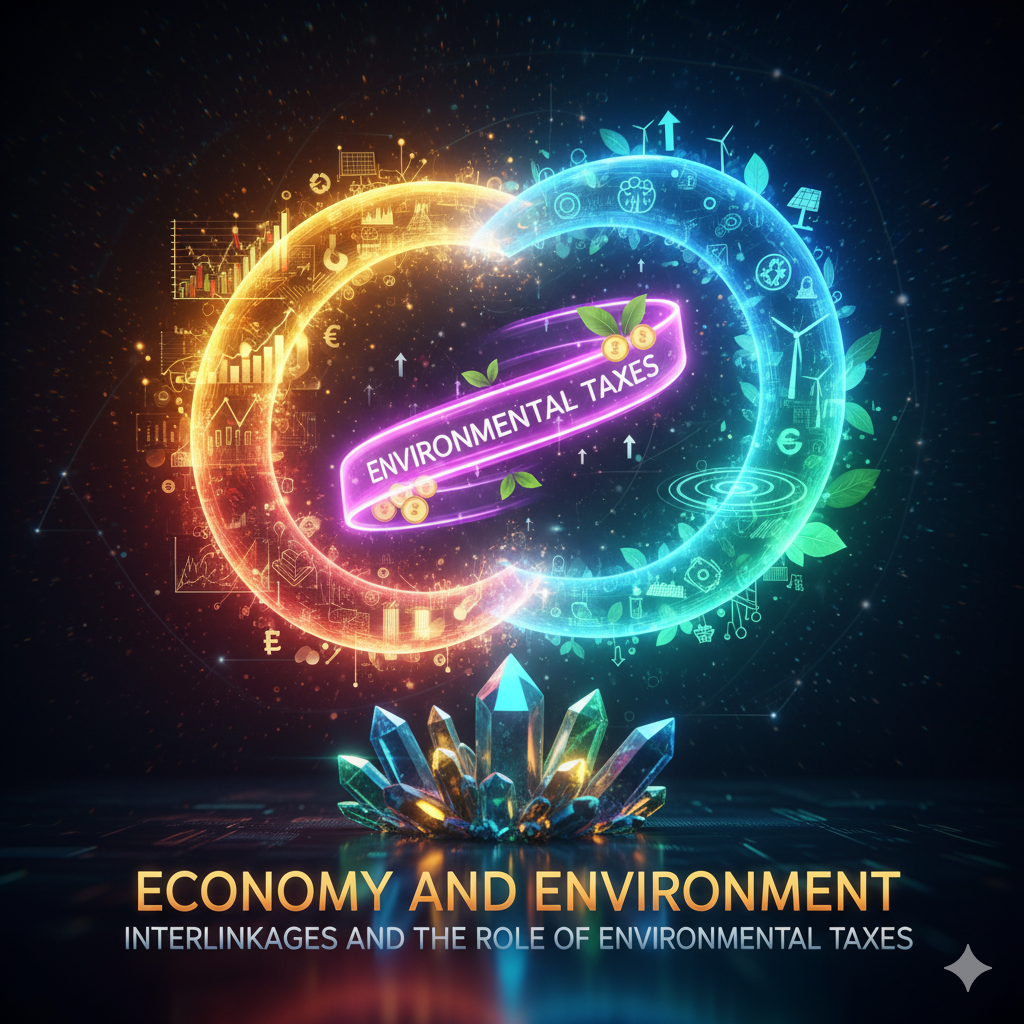Introduction
The relationship between the economy and the environment is one of the most crucial and complex aspects of modern development. The economy depends heavily on the natural environment for raw materials, energy, water, and ecological services, while economic activities often put pressure on the environment through pollution, resource depletion, and ecosystem degradation. Striking a balance between economic growth and environmental sustainability has thus become a central challenge for governments and policymakers across the world.
As nations progress, economic growth often comes at the expense of the environment—industrialization, urbanization, and overexploitation of natural resources lead to air and water pollution, deforestation, and climate change. In recent years, this unsustainable path has forced policymakers to rethink the traditional growth model and adopt new mechanisms such as environmental taxes to integrate ecological sustainability into economic decision-making.
🌱 Understanding the Economy and Environment Relationship
1. The Economy’s Dependence on the Environment
The economy and environment are interdependent systems. Economic activities such as agriculture, mining, manufacturing, transportation, and services rely on the environment for:
- Natural resources (like minerals, timber, fossil fuels, water, and soil fertility),
- Ecosystem services (like climate regulation, waste assimilation, and biodiversity).
Without these resources, production processes would halt. Thus, the environment forms the foundation of the economic system.
However, the exploitation of these resources beyond their regenerative capacity leads to environmental degradation. This imbalance often manifests in the form of pollution, deforestation, soil erosion, and biodiversity loss, which in turn impact economic stability and human welfare.
2. The Environmental Impact of Economic Activities
Economic development, if unregulated, often leads to ecological damage. Major environmental impacts include:
- Air Pollution: Emissions from industries and vehicles lead to health hazards and global warming.
- Water Pollution: Industrial effluents and agricultural runoff degrade water quality.
- Deforestation: Clearing forests for agriculture and infrastructure reduces biodiversity.
- Climate Change: Excessive greenhouse gas emissions alter global weather patterns.
- Waste Generation: Urbanization leads to increased solid and hazardous waste.
Thus, economic growth must be coupled with sustainable practices that minimize ecological harm.
3. The Concept of Sustainable Development
To balance economic and environmental objectives, the idea of sustainable development emerged — defined by the Brundtland Commission (1987) as “development that meets the needs of the present without compromising the ability of future generations to meet their own needs.”
This concept emphasizes three pillars:
- Economic Growth: Improving income and productivity.
- Social Inclusion: Ensuring equality and welfare.
- Environmental Protection: Conserving natural systems.
Sustainable development promotes green economy practices—using renewable resources, improving energy efficiency, and enforcing environmental laws and taxes.
💰 Economic Instruments for Environmental Protection
Traditionally, environmental regulation was achieved through command-and-control policies like emission standards and bans. However, these methods often lack flexibility and economic efficiency.
Modern environmental economics advocates the use of market-based instruments that create financial incentives for environmental protection. Among these tools, environmental taxes play a vital role.
🌍 What are Environmental Taxes?
1. Definition
Environmental taxes (also known as green taxes or eco-taxes) are fiscal instruments designed to discourage environmentally harmful activities and promote sustainable practices.
They impose a cost on pollution or resource use, encouraging producers and consumers to adopt eco-friendly behavior.
The OECD defines environmental taxes as:
“Taxes whose base is a physical unit (or proxy) of something that has a proven, specific negative impact on the environment.”
2. Objectives of Environmental Taxes
Environmental taxes serve multiple goals:
- Pollution Control: By increasing the cost of polluting activities, they reduce emissions.
- Resource Conservation: Encourage efficient use of natural resources.
- Revenue Generation: Provide funds for environmental programs and green technologies.
- Behavioral Change: Promote sustainable consumption and production patterns.
- Innovation Incentives: Encourage industries to adopt cleaner technologies.
Thus, environmental taxes combine economic efficiency with ecological responsibility.
⚙️ Types of Environmental Taxes
Environmental taxes can be classified based on their targets or sectors. The main types include:
1. Energy Taxes
- Levied on fuels like coal, petrol, diesel, and natural gas.
- Aim to reduce energy consumption and carbon emissions.
- Example: Carbon Tax—a tax imposed on the carbon content of fossil fuels.
2. Pollution Taxes
- Imposed on emissions discharged into air, water, or soil.
- Example: Taxes on sulfur dioxide (SO₂) or nitrogen oxides (NOₓ) emissions by industries.
3. Resource Taxes
- Applied to the extraction or use of natural resources such as timber, water, or minerals.
- Encourage sustainable resource management and recycling.
4. Transport Taxes
- Levied on vehicles based on their fuel efficiency, age, or emission standards.
- Example: Higher registration fees for high-emission vehicles.
5. Waste Management Taxes
- Imposed on landfill disposal or waste generation.
- Encourage recycling and composting.
6. Product-based Taxes
- Target environmentally harmful products like plastic bags, pesticides, or batteries.
- Example: Plastic bag levy to reduce single-use plastics.
📈 Economic Theory Behind Environmental Taxes
The concept of environmental taxes originates from the Pigovian Tax Theory, proposed by economist Arthur Pigou in the early 20th century.
According to Pigou, environmental pollution is a negative externality—a cost imposed on society that is not reflected in the market price. For instance, a factory that pollutes the air increases healthcare costs for society but does not pay for it.
A Pigovian tax corrects this by internalizing the external cost—making polluters pay for the damage they cause. This leads to an optimal balance between production and environmental protection.
🌎 Global Examples of Environmental Taxes
1. Sweden
- Introduced a carbon tax in 1991.
- Tax rates vary based on fuel type; revenue is used for renewable energy development.
- Result: 25% reduction in emissions since 1990 while maintaining economic growth.
2. Germany
- Implements taxes on fuel, electricity, and vehicles.
- Part of the “Ecological Tax Reform” program to reduce CO₂ emissions.
3. United Kingdom
- Introduced the Climate Change Levy (CCL) in 2001.
- Encourages businesses to improve energy efficiency.
4. Japan
- Charges a Global Warming Tax on fossil fuels since 2012.
- Funds are allocated for clean energy research.
5. India
- India has introduced several green taxes:
- Clean Energy Cess on coal (2010), replaced by GST Compensation Cess.
- Green Tax on older vehicles.
- Plastic Waste Management Fee.
- Pollution Control Boards Fees and Levies for industrial emissions.
Environmental Taxes and Economic Policy in India
India, as a developing country, faces the dual challenge of achieving high economic growth while ensuring environmental sustainability. Environmental taxation forms an important part of its strategy.
1. Clean Energy Cess
- Introduced in 2010 on coal, lignite, and peat at ₹50 per tonne, later increased to ₹400 per tonne.
- Used to fund the National Clean Energy Fund (NCEF) to promote renewable energy and cleaner technologies.
2. Green Tax on Vehicles
- Imposed on older vehicles that contribute to high pollution.
- Collected by state transport departments to fund pollution control measures.
3. Plastic Waste Levy
- Imposed by several state governments to curb plastic use.
- Promotes biodegradable alternatives.
4. Carbon Market Mechanisms
- India is working towards establishing a National Carbon Market, under the Bureau of Energy Efficiency (BEE).
- Supports industries to reduce emissions through carbon credits.
5. Other Environmental Fees
- User charges for water usage, waste collection, and effluent discharge.
- Environment Compensation Charges (ECC) imposed by the National Green Tribunal (NGT).
🧭 Advantages of Environmental Taxes
- Promotes Sustainable Growth: Encourages resource-efficient production and consumption.
- Revenue Generation: Provides financial support for green programs.
- Market Efficiency: Internalizes environmental costs, leading to optimal resource allocation.
- Encourages Innovation: Industries invest in clean technology to reduce tax burdens.
- Public Health Improvement: Reduces pollution-related diseases.
- Supports Climate Goals: Helps meet international commitments like the Paris Agreement.
⚠️ Challenges and Limitations
Despite their benefits, environmental taxes face several challenges:
- Administrative Difficulties: Measuring pollution accurately can be complex.
- Regressive Impact: Higher fuel or energy costs can affect lower-income groups.
- Industry Opposition: Resistance from polluting sectors fearing loss of competitiveness.
- Revenue Misallocation: Funds collected may not always be used for environmental purposes.
- Lack of Awareness: Public resistance due to misunderstanding of eco-taxes as a financial burden.
- Weak Enforcement: In developing countries, tax evasion and weak monitoring reduce effectiveness.
To overcome these issues, environmental taxation must be designed with equity, transparency, and proper reinvestment of revenues.
🌏 Way Forward: Integrating Economy and Environment
- Green Fiscal Reform: Shift taxation from income and labor towards pollution and resource use.
- Polluter Pays Principle: Strictly enforce this concept to ensure accountability.
- Revenue Recycling: Use green tax revenues to subsidize renewable energy, public transport, and afforestation.
- Public Awareness: Educate citizens on environmental costs and sustainable behavior.
- Corporate Responsibility: Encourage businesses to adopt Environmental, Social, and Governance (ESG) frameworks.
- Global Cooperation: Strengthen international collaboration on carbon pricing and environmental financing.
A well-designed environmental tax system can thus serve as a powerful tool for green transformation, ensuring that economic progress aligns with ecological sustainability.
🧩 Conclusion
The intricate link between the economy and environment reflects the need for an integrated approach to development. Economic activities cannot be sustained if environmental degradation continues unchecked. Therefore, environmental taxes play a pivotal role in correcting market failures and guiding societies toward sustainable development.
By internalizing environmental costs and rewarding sustainable practices, environmental taxation not only protects nature but also fuels innovation, efficiency, and long-term economic resilience.
For India, the path forward lies in strengthening green fiscal policies, improving tax governance, and channeling revenues toward clean technologies and renewable energy. Balancing economy and environment is no longer a choice—it is a necessity for ensuring prosperity, equity, and sustainability for future generations.




